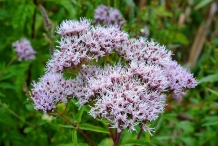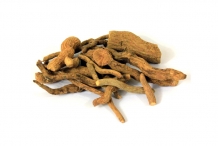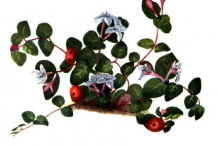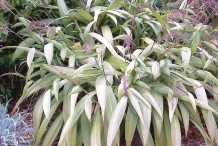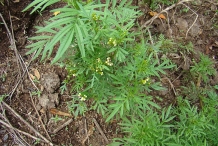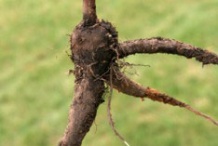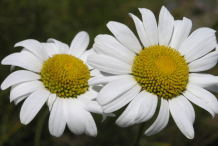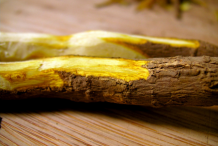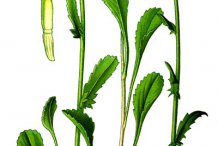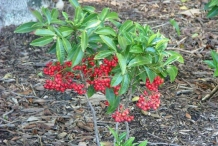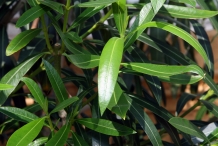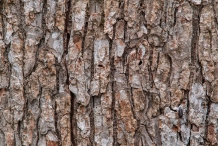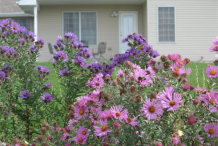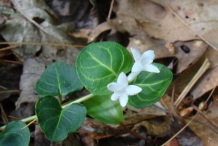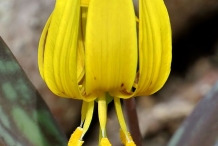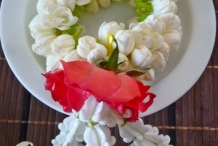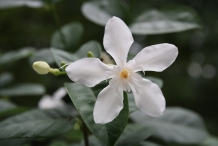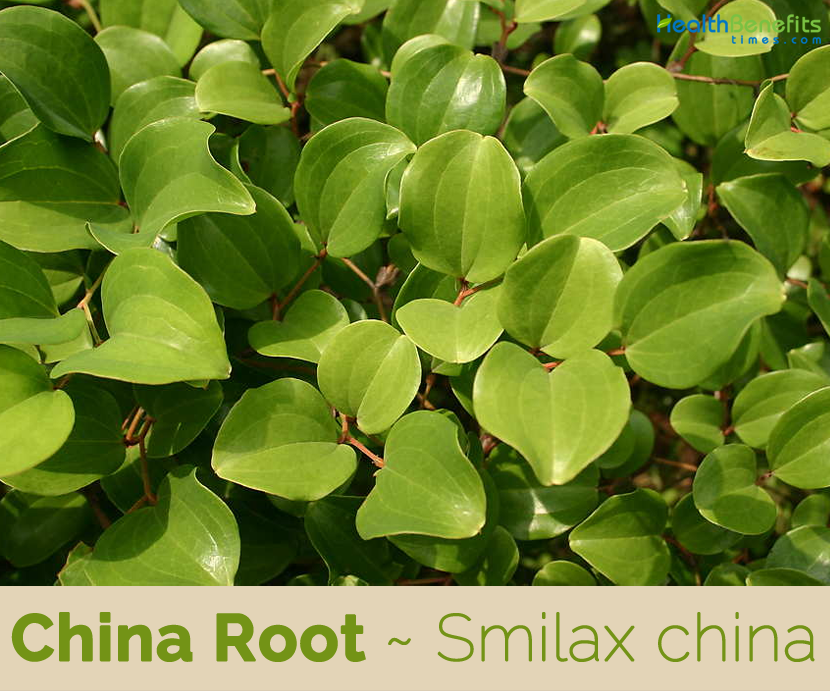 Chobchini or China root scientifically known as Smilax china has been used for ages in numerous tribal and folk medicine for a large number of health issues. Chobchini is hailed as a wonder medicine in Ayurveda and Unani too. The plant is native to China, Korea, Taiwan, Japan (including Ryukyu and Bonin Islands), Philippines, Vietnam, Thailand, Myanmar, and Assam. Root or rhizome of Smilax is used in herbal formulations in several parts of the world. China cultivates this drug in large amount and for most of the countries it is exported from there. Hence it is usually recognized as China Root. It is a plant species in the genus Smilax and Smilacaceae (Catbrier family). Some of the popular common names of the plants are China root, Chinese smilax and Bamboo Briar Root.
Chobchini or China root scientifically known as Smilax china has been used for ages in numerous tribal and folk medicine for a large number of health issues. Chobchini is hailed as a wonder medicine in Ayurveda and Unani too. The plant is native to China, Korea, Taiwan, Japan (including Ryukyu and Bonin Islands), Philippines, Vietnam, Thailand, Myanmar, and Assam. Root or rhizome of Smilax is used in herbal formulations in several parts of the world. China cultivates this drug in large amount and for most of the countries it is exported from there. Hence it is usually recognized as China Root. It is a plant species in the genus Smilax and Smilacaceae (Catbrier family). Some of the popular common names of the plants are China root, Chinese smilax and Bamboo Briar Root.
It is an Ayurvedic herb, quite interestingly this herbal root got famous in the treatment while treating the Gout of King Charles V. Roots are the most common used part. Stems are also equally beneficial. The rhizome of Chobchini can be used in the form of powder or paste, cooked or raw. The daily intake should not exceed 10 grams a day, as heavy dosage may result in nausea and vomiting. The most important medicinal properties of Chobchini however, are its ability to fight psoriasis, syphilis and leprosy. It is a preferred herbal treatment for psoriasis.
Plant Description
China root is a hard tendril climbing vine that grows up to 5 meter long. The plant is found growing in shrub thickets in hills and mountains, forests, thickets, hillsides, grassy slopes, shaded places along valleys or streams from near sea level. It prefers moist, well-drained soil for better growth. The plant has hard, large, knotty, uneven rhizome, blackish externally, pale colored or whitish internally. Stem is woody, sparsely prickly, and 1–5 m (3 ft. 3 in–16 ft. 5 in) long.
Leaves
Leaves are simple, alternate, elliptically oblong to sub-rounded, 5 to 8 centimeters long, 2.5 to 4 centimeters wide; those toward the end of the branches are much smaller and veined. Petioles are about 7 millimeters long, with adnate spiculate stipules which frequently are extended into tendrils.
Flowers & Fruits
The inflorescence is born in axil of young leaf, of one umbel of both sexes which 10-25 flowered, representing sub globose and base sub globose measuring 2-3 mm in diameter with many small bracteoles. The male flowers have sepals of yellowish green and measuring 3.5-4.5 x 1.5-2.5 mm. The stamens measure 3-4 mm. The filaments are filiform in shape. The female flowers have six staminodes. Flowers are followed by globose red berries that measures 0.6-1.5 cm in diameter and minutely white powdery.
Ayurveda and Unani doctors recommend China Root for white discharge or leucorrhea in women. It has been found to be quite effective in controlling the problem. China Root contains several medicinal properties including control of swellings (anti-inflammatory), removal of pus from wounds, promotion of urine (diuretic), bringing down high body temperature, removing gas (flatulence) and clearing bowels.
Traditional uses and benefits of China Root
- Root is alterative, anti-scrophulatic, carminative, depurative, diaphoretic, diuretic and tonic.
- It is considered useful when taken internally in the treatment of old syphilitic cases and is also used for certain skin diseases, including psoriasis, rheumatoid arthritis, gout, enteritis, urinary tract infections, skin ulcers etc.
- Large doses can cause nausea and vomiting, which is appreciated in weakened and depraved conditions due to a poisoned state of the blood.
- Smilax is helpful in improving muscle mass and body strength.
- It is used as a tonic for male sexual energy.
- Smilax has a special property as it acts against the problems caused due to malnourishment of Dhatus such as poor immunity and weakness.
- Decoction of roots and rhizomes used as depurative in cases of herpetism and syphilis in Philippines.
- In India, used to some extent like sarsaparilla, in decoction as a depurative, diaphoretic, stimulant, alterative, antisyphilitic, and aphrodisiac.
- It is Sudorific and demulcent, used in rheumatism.
- It is used as alterative in old syphilitic cases and in chronic rheumatism.
- It is used for various skin diseases.
- It is used for syphilis, skin diseases, epilepsy, insanity, flatulence, dyspepsia, constipation, fever, neuralgia, rheumatism, gout and general debility in Ayurveda, Siddha and Unani medical system.
- In traditional Chinese medicine, used as diuretic and for treatment of rheumatic arthritic conditions; also used for detoxification, treatment of gout, tumors, and lumbago.
- It is used as a remedy for inflammatory disease and ischuria in Korea.
- Rhizome is made into a paste and applied to painful swellings.
- It has also been supported in the treatment of leprosy, scrofula and many skin infections developing into ulcers.
- Roots had been used to treat abscesses, pyoderma and burns.
- It was one of the drugs used in the treatment of Acute Appendicitis, taeniasis and constipation in Korea.
- Roots have been used to treat cases of paralysis and sciatica.
- It is used to treat urinary tract infection, stone and ulcers of the bladder and even chyluria by the physicians of Hong Kong.
- It helps in relieving strangury and also seminal weakness.
- It is also given sometimes to treat fever and other inflammatory conditions associated with fever like acute lymphadenitis.
Ayurvedic Health benefits of China root
- Energy Tonic: Take dried form of 10 gram Burdock Fruit, 10 gram of Chaenomeles Speciosa, 20 gram of Mandarin Orange, 10 gram of Acorus Gramineus Rhizome, 10 gram of China Root, 20 gram of Snow Lotus Root, 10 gram of Glehnia Root, 20 gram of Yam Rhizome, 10 gram of Ginseng Siberian Root, 20 gram of Stevia Leaves, 10 gram of Liquorice and 5 gram of Clove Bud. Put all ingredients in a grinder. Make powder. Store in a jar. Boil half a teaspoon in a cup of water. Strain. Have it early in the morning. This tonic increases your stamina and feels you energetic whole day. It cleans liver and gallbladder by removing toxicity. Results healthy and ideal immune system, good digestive system and keeps away morning sickness. Try it.
- Impotency and Seminal disorders: 2-3 gram of China root is added to a cup of water and a cup of milk. Boil together, till the quality reduced to half. Filter. This is taken once daily by adding small amount of sugar. This is wonderful benefits in impotency and seminal disorders, low sperm count.
- Chronic arthritis and secondary and tertiary Syphilis: 4-5 gram of the coarse root powder is cooked well with 200 ml of water and reduced to 560 ml. Filtered and consume. 2-3 weeks medication gives good result in arthritis and secondary and tertiary Syphilis.
- Schizophernia and epilepsy: 10 Gram of China root is added with 50 ml water. Macerated, filtered. This infusion is consumed early in the morning or in late evening. This is considered to be a very effective medicine while treating epilepsy, insomnia and Schizophernia.
- Pemphigus and Skin diseases: Equal amount of Sarsaparilla and China root are taken and made into decoction. This is taken twice daily for the complaints such as Pemphigus and chronic Skin diseases.
- Osteo-arthritis: 1-2 gram of the powder is mixed with honey in cases like arthritis and neuralgia. It contributes significant benefits in above complaints.
- Leucorrhea or white discharge: Leucorrhea or white discharge can be controlled effectively by taking Chobchini with milk. Take Chobchini rhizome from an herbal shop, powder it and keep it in a dry and clean bottle. Take 5 mg of Chobchini powder, mix it in milk and drink it.
- Relieving Joint Numbness: Medicated wine with Smilax China root is taken orally to relieve joint numbness or tingling.
- Diabetes: A decoction of Smilax China root and fructus mume can be used in treating diabetes.
- Excretory System: Powdered Smilax China root is taken with rice paste to treat urolithiasis.
Culinary uses
- Large and fleshy roots can be dried and ground into a powder.
- Young shoots and leaves can be consumed raw or cooked.
- Fruit are consumed raw to quench the thirst.
- A tea is made from the leaves.
Precautions
- Avoid excessive dosages it may causes nausea and vomiting.
- Vinegar should not be used while using the herb.
- Pregnant and lactating women should avoid China Root formulations as it may affect their health.
References:
https://www.itis.gov/servlet/SingleRpt/SingleRpt?search_topic=TSN&search_value=506036#null
https://davesgarden.com/guides/pf/go/117257/
https://pfaf.org/user/Plant.aspx?LatinName=Smilax+china
http://www.theplantlist.org/tpl1.1/record/kew-288437
http://www.ccba.bc.ca/discuss1/_disc1/00000872.htm
https://botanical.com/botanical/mgmh/s/smilax55.html
https://en.wikipedia.org/wiki/Smilax_china
https://plants.usda.gov/core/profile?symbol=SMCH


